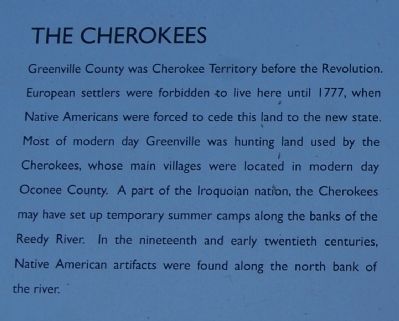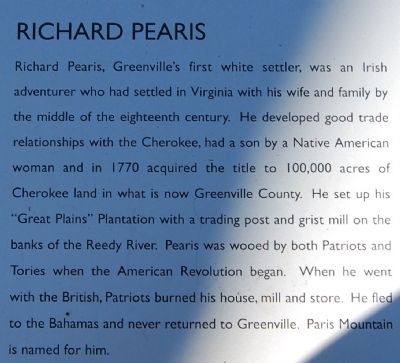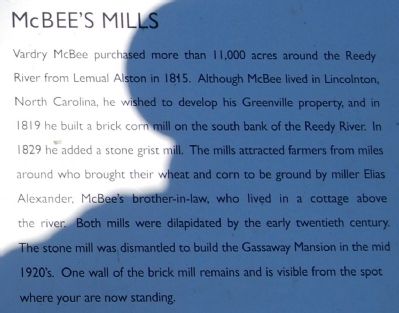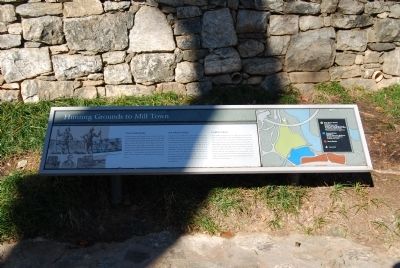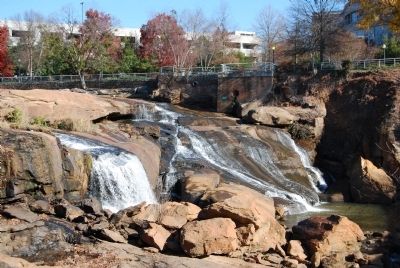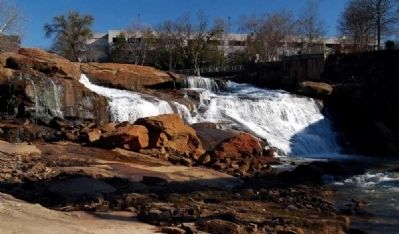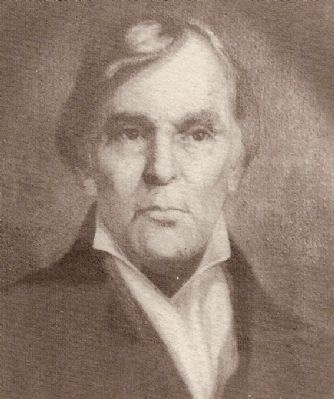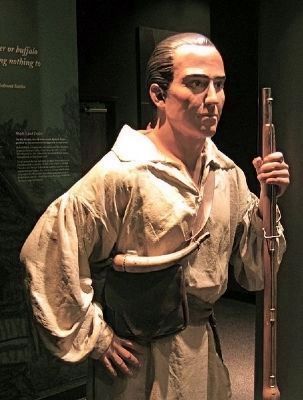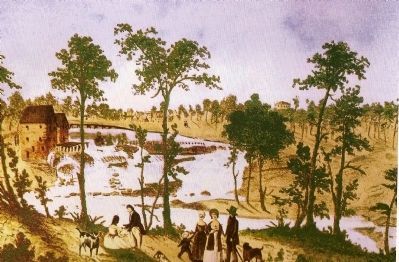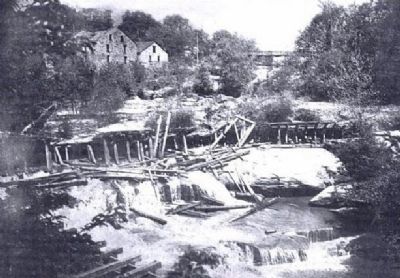Greenville in Greenville County, South Carolina — The American South (South Atlantic)
Hunting Grounds to Mill Town
The Cherokees
Greenville County was Cherokee Territory before the Revolution. European settlers were forbidden to live here until 1777, when Native Americans were forced to cede this land to the new state. Most of modern day Greenville was hunting land used by the Cherokees, whose main villages were located in modern day Oconee County. A part of the Iroquoian nation, the Cherokees may have set up temporary summer camps along the banks of the reedy River. In the nineteenth and early twentieth centuries, Native American artifacts were found along the north bank of the river.
McBee's Mills
Vardry McBee purchased more than 11,000 acres around the reedy River from Lemual Alston in 1815. Although McBee lived in Lincolnton, North Carolina, he wished to develop his Greenville property, and in 1819 he built a brick corn mill on the south bank of the Reedy River. In 1829 he added a stone grist mill. The mills attracted farmers from miles around who brought their wheat and corn to be ground by miller Elias Alexander, McBee's brother-in-law, who lived in a cottage above the river. Both mills were dilapidated by the early twentieth century. The stone mill was dismantled to build the Gassaway Mansion in the mid 1920's. One wall of the brick mill remains and is visible from the spot you are now standing.
Richard Pearis
Richard Pearis, Greenville's first white settler, was an Irish adventurer who had settled in Virginia with his wife and family by the middle of the eighteenth century. He developed good trade relationships with the Cherokee, had a son by a Native American woman and in 1770 acquired the title to 100,000 acres of Cherokee land in what is now Greenville County. He set up his "Great Plains" Plantation with a trading post and grist mill on the banks of the Reedy River. Pearis was wooded by both Patriots and Tories when the American Revolution began. When he went with the British, Patriots burned his house, mill and store. He fled to the Bahamas and never returned to Greenville. Paris Mountain is named for him.
Topics. This historical marker is listed in these topic lists: Industry & Commerce • Native Americans • Notable Buildings • Waterways & Vessels. A significant historical year for this entry is 1777.
Location. 34° 50.683′ N, 82° 24.083′ W. Marker is in Greenville, South Carolina, in Greenville County. Marker is on South Main Street. Marker is located on the second level north, under the bridge. Touch for map. Marker is in this post office area: Greenville SC 29605, United States of America. Touch for directions.
Other nearby markers. At least 10 other markers are within walking distance of this marker. Reedy River Falls (here, next to this marker); Liberty Bridge (here, next to this marker); McBee's Mills (here, next
to this marker); Paul Ellis, III Overlook (here, next to this marker); History of Falls Park (within shouting distance of this marker); The Reedy River (within shouting distance of this marker); Harriet Smith Wyche (within shouting distance of this marker); Tate Plaza (within shouting distance of this marker); Falls Place (within shouting distance of this marker); Vardry Dixon Ramseur, III (within shouting distance of this marker). Touch for a list and map of all markers in Greenville.
Related markers. Click here for a list of markers that are related to this marker. Three markers designating the Cherokee boundary between 1767 and 1777.
Also see . . .
1. Cherokee Nation. Official website of the Cherokee Nation. (Submitted on March 3, 2010, by Brian Scott of Anderson, South Carolina.)
2. Cherokee. The Cherokee (ᏣᎳᎩ) are a Native American people historically settled in the Southeastern United States (principally Georgia, the Carolinas and Eastern Tennessee). (Submitted on March 3, 2010, by Brian Scott of Anderson, South Carolina.)
3. Greenville County, South Carolina. Greenville County is a county located in the state of South Carolina, United States. (Submitted on December 20, 2008, by Brian Scott of Anderson, South Carolina.)
4. Greenville, South Carolina. Greenville is a mid-sized city located in the upstate of South Carolina. It is the county seat of Greenville County and the principal city in the Greenville-Mauldin-Easley Metropolitan Statistical Area (MSA). (Submitted on December 20, 2008, by Brian Scott of Anderson, South Carolina.)
5. Richard Pearis. Richard Pearis (1725–1794) was an Indian trader, a pioneer settler of Upstate South Carolina, and a Loyalist officer during the American Revolution. (Submitted on December 20, 2008, by Brian Scott of Anderson, South Carolina.)
Additional commentary.
1. About Vardry McBee
Vardry McBee was perhaps the most pivotal figure in the history of our city and Greenville County as a whole. thanks to his business acumen and impressive foresight for how the community could grow and prosper.
A product of the Carolina frontier, McBee was born in 1775 on the eve of the American Revolution, a conflict that would prove formative in his early years. Both his father and older brother fought with the Patriots, at King's Mountain and the Battle of Cowpens. McBee himself never fought for American independence, but instead used his considerable fortune to improve the lives of his fellow citizens, appropriating his land and fortunes to public projects.
McBee opened the first textile mill on the Reedy River, but he saw value in a diversified economy. In his private business life, that meant he owned two flour mills, a cotton factory, and wool and paper mills. Publicly, even as he approached his 80s, it led him to champion the construction of a railroad line that connected Columbia and Greenville. In 1853, this line became the first rail to serve the community, and it would eventually become a turning point in the economy of the town. (Source: G: The Magazine of Greenville, Jan/Feb 09, pg 66.)
— Submitted March 3, 2010, by Brian Scott of Anderson, South Carolina.
2. More About Vardry McBee
The early history of Greenville had no more interesting or significant figure than Vardry McBee, who in fact measured up to all that was intended when he was called "a model man of enterprise for the South and the country." After he had passed the high tide of life's activities, and twelve years before his death, which occurred at Greenville, January 23, 1864, in his eighty-ninth year, an interesting sketch of his career was published in De Bow's Review of September, 1852. It is a historic document, and the salient features of the article are reproduced here.
He was born in Spartanburg District of South Carolina, June 19, 1775, and the Revolutionary battles of Cowpens and Cedar Springs were fought within a few miles of his father's home, and he was old enough to see and be impressed by many events of that struggle. His parents came from Virginia and were among the earliest settlers of Upper Carolina. His father, though of the religious faith of the Friends, commanded a company for several years in the Revolution. After the war, being heavily in debt, he had to mortgage his property, including the famous Limestone Springs, and finally lost his fortune altogether.
Vardry had to leave school at the age of twelve and for the next six years was a farm laborer on the Limestone Farm, where his father remained, though the title had passed to other owners. In 1794 he began an apprenticeship at the saddler's trade at Lincolnton, North Carolina. During 1800, after completing his apprenticeship he was employed for a brief time as a clerk in Charleston, but in the fall of the same year accompanied his parents on their removal to Kentucky. The following year he established a saddlery in middle Tennessee, but soon returned to North Carolina and engaged in business as a merchant at Lincolnton, where he prospered and laid the foundation of a large fortune. In 1805 he retired from mercantile lines, and devoted his time to agriculture and other increasing interests. Agriculture was his favorite subject, and he reclaimed a large amount of badly worn soil and again and again carried off premiums for maximum productiveness of his fields. Fully three-quarters of a century ago he was practicing the modern doctrine of restoring soil fertility by the use of clovers and other leguminous crops. In 1812 he was elected clerk of the County Court at Lincolnton and held that office twenty-one years.
While Mr. McBee did not become a resident of Greenville until 1836, he had bought in 1815 a large domain of several thousand acres in and around the village. At that time he had only a modest fortune, as fortunes were then estimated, and it was against the protests of friends and relatives that he bargained with Col. L.J. Allston for these lands at a price of $27,500. While a few acres of the property at the present time would appraise at more than that figure, it required unusual sagacity and foresight to approve the wisdom of the purchase 100 years ago. Greenville then contained only a few houses and about a hundred inhabitants, but Mr. McBee saw it on one of the great western thoroughfares, recognized its climatic and topographic advantages, and particularly the immense water power which would make a great center of industry.
Soon after making the purchase he gave his personal impetus to industrial progress, building a flour mill in the village in 1817, another one of stone in 1829. Seven miles below the city on Reedy River, he developed from time to time a nucleus of manufactures, including grist mill, paper mill, cotton factory, and woolen mill —- all pioneer industries that have special interest to the modern industrial City of Greenville.
After removing to Greenville in 1836 he devoted himself to the improvement of his lands and agriculture. He would have been an exceptional farmer even in the twentieth century, since he abhorred the idea of "mining" the wealth of the soil, and always practiced the sound policy of steadily making his land better.
He was extremely liberal toward every local improvement. He gave lands for tht male and female academy at Greenville and sites for the various churches. In the history of early railroad construction through this part of the South his name and service are indelibly fixed. He succeeded General Hayne as president of the project of the Louisville & Cincinnati Railroad. When the project of the Greenville & Columbia Railroad was about to fail, he subscribed $50,000, thus making the largest individual subscription ever made to a railroad in the United States up to that time. He also liberally supported the enterprises of the Seaboard & Rpanoke and the Charleston, Louisville & Cincinnati Railroads.
To quote the direct words of the article from which the above is taken: "It may with great truth be said of Mr. McBee, that very few men who have made their fortunes have appropriated so much of them to public purposes * * * Mr. McBee never engaged in an enterprise that did not succeed. As a saddler he commenced his fortune, had a high reputation for his work, and laid the foundation of that immense estate which he now owns. As a merchant, with numerous branches of his mercantile business at Lincolnton, Spartanburg, Greenville and elsewhere, during some fifty years, he has been everywhere successful. As an extensive manufacturer of cotton and woolen cloths and paper he has been equally successful.
"In morality and all the proprieties of life, Mr. McBee has no superior. His habits are all strictly temperate and methodical. He is a man of great industry and activity. He retires to bed early and arises before daylight every morning. Having been crippled when a young man, by being thrown from a horse, he is not able to walk any distance. He consequently lives mostly in his saddle during the day. Although now nearly seventy-seven years old, he rides fifty miles a day, and feels no inconvenience from it. He enjoys fine health, though his constitution has always been delicate. There is the same uniformity and regularity in his dress that there is in his habits and manners. In person, Mr. McBee is small, with a mild and pleasing expression of face. In his manners he is kind and gentle, with the simplicity of a child. Seldom is he excited by anything, but there is in him a sleeping passion which is sometimes aroused."
In 1804 he married Miss Jane Alexander, daughter of Col. Elias Alexander of Rutherford County, North Carolina. The unfretted currents of their lives ran side by side for nearly sixty years, and she died less than two months after her beloved husband on March 13, 1864. A granddaughter of this historic couple is Mrs. C.M. Landrum of Greenville, from whom this data was secured. (Source: History of South Carolina, Volume 4 by Yates Snowden, pgs 261-262.)
— Submitted March 3, 2010, by Brian Scott of Anderson, South Carolina.
3. Colonel Richard Pearis
Richard Pearis was born in Ireland and settled in Frederick county, Virginia, before 1750. At the outbreak of the Revolutionary war he was a successful planter and Indian trader on the Enoree river in South Carolina.
An orator of rude, savage eloquence and power, he commended himself to Governor Dinwiddie by
his loyalty and efficiency. He became lieutenant in the Virginia Provincial regiment in 1755 and was commissioned captain in 1756 to command a company of Cherokees and Catawbas in an expedition against the Shawnee towns west of the Ohio, under Major Andrew Lewis. Pearis served under Generals Forbes, Stanwix, Monckton, and Bouquet. He was the first to enter Fort Duquesne. His military ability was apparent in his services on the borders of Maryland, Pennsylvania, and Virginia, with headquarters at Fort Pitt.
Having married a Cherokee wife, Captain Pearis acquired great influence among the Indians, and was consequently ordered south. In 1768 he was settled at the Big Canebrake, on the Reedy river, South Carolina.
Every effort was made by the Whigs in 1775 to induce this powerful man and the Indians to join them, or at least to secure their neutrality. However, Pearis took part in the siege of Ninety Six on the British side (see page 71) and many other actions.
In July, 1776, he was one of a party of 260 loyal militia and Indians which unsuccessfully attacked 450 "rebels" in a wooden fort.
According to his own narrative, his services to the crown in the same year include the dispersal of 700 "rebels" in the district of Ninety Six. By the turn of fortune he was captured and consigned to Charleston jail, where he was a prisoner in irons for nine months.
On his release, Pearis wended his way on foot, traversing 700 miles, to West Florida, through the settlements of the Indians, who supplied him with food. Arriving at Pensacola, he was on 13 December, 1777, commissioned captain in the West Florida loyalist refugees, by Colonel John Stuart, superintendent of Indians in the Southern Colonies, who ordered him to capture Manshac on the Mississippi river, a task which he accomplished. This corps was also engaged in the suppression of the rum trade at Mobile Bay with the northern Creek Indians. Pearis was present at the capture of Sunbury in Georgia.
The romantic tale of his exploits includes the raising of 5000 to 6000 loyalists and the disarming of all rebels from the Savannah river to Broad river, near the borders of North Carolina, as well as destroying their forts and capturing men, arms and ammunition. To his mortification, this series of successes was no sooner accomplished than Colonels Innes and Balfour ordered the arms and ammunition to be returned to the "rebels" and their leaders released. Incensed by this treatment, he returned to Georgia and settled his family near Augusta.
While Pearis was a prisoner at Charleston, his wife, two daughters, and a son were surprised at home by Colonel John Thomas and 400 followers, who subjected them to abuse and punishment, as well as carrying away their portable property and burning the rest. Not content, Colonel Thomas forced the family to march on foot 25 miles a day, without food and without protection for their heads from the sun. They were also confined for three days without food, and were afterwards sent off in an open wagon a distance of 100 miles, to shift for themselves among "a parcel of rebels," without money or provisions. For three years Captain Pearis was separated from his family, who were in daily fear of massacre by their enemies.
A son of Captain Pearis was an ensign in the West Florida Rangers.
For the loss of his real estate in South Carolina, Colonel Richard Pearis claimed £15,576. 18s. and was awarded £5,624. An account of his property has been published. in S.C. Hist, and Gen. Mag., Vol. XVIII, pp. 97-9. The name appears also as Paris, whence Paris Mountain, near Greenville in South Carolina.
After the war he settled in Abaco in the Bahamas, where he had a grant of 140 acres of land, and where Margaret Pearis, presumably his wife, received a grant of 40 acres. Colonel Pearis received a military allowance of £70 a year from 1783 to 1804, when he probably died. It was perhaps his son, Richard, who married Margaret, daughter of General Robert Cunningham, the South Carolina loyalist, in Abaco, 22 June, 1790. (Source: Contributions in History and Political Science, Issue 7 by Ohio State University (1921), pgs 102-104.)
— Submitted March 3, 2010, by Brian Scott of Anderson, South Carolina.
4. Richard Pearis
The most significant effort to secure Greenville land-and the most successful-was made by Virginia Indian trader Richard Pearis. Born in Ireland in 1725, he was the son of George and Sarah Pearis who immigrated to the Shenandoah Valley of Virginia with three sons and a daughter. George Pearis was a devout Presbyterian and a man of considerable property. By 1750 Richard owned 1,200 acres of land near Winchester. He and his wife Rhoda had three children-Richard, Elizabeth, and Sarah. Three years later Pearis was trading with the Cherokee Nation and served as an Indian agent for Governor Robert Dinwiddie. He formed a partnership with Nathaniel Gist, and they opened a store for trade with the Overhill Towns at Fort Robinson on Long Island in the Holston River, the site of present-day Kingsport, Tennessee. The partnership soon dissolved, but Pearis continued his trading activities. As early as 1754 Pearis was traveling in South Carolina among the Cherokees of the Lower Towns. Like other traders, Pearis fathered a child by a Cherokee woman; Pearis named this child George. During the Seven Years War Pearis led a company of 130 Cherokee warriors under the command of Major Andrew Lewis. At the conclusion of the war in 1763, Pearis served as Indian agent for Maryland.
In October 1768 at a congress with Indian leaders at Hard Labor Creek, near Ninety Six, John Stuart proposed extending the Indian boundary through Virginia along a line east of some white settlements. Virginia Governor Lord Botetourt and the House of Burgesses opposed the move, and Stuart proposed a second congress be held at Cameron's plantation, Lochaber, near Ninety Six, in October 1769. Since Stuart seemed adamant about the location of the boundary, the Virginia commissioners-Andrew Lewis, Richard Pearis's old commander, and Dr. Thomas Walker ployed Pearis and Jacob Hite to sabotage the meeting at Lochaber.32
A neighbor of Pear is in Virginia, Hite was the son of Joist Heydt (Heidt or Hite), a land speculator who had settled in the Shenandoah Valley in 1731 on a grant of 100,000 acres. The younger Hite began the traditional ascent to prominence in colonial Virginia politics by serving as a justice of the peace, a member of the county court, and eventually as sheriff. Two of his sons, John Jr. and Thomas, later served in the House of Burgesses.33
Hite, a member of the frontier gentry, and Pearis, with his long experience among the Cherokees, were ideal for the mission. Hite forged a series of letters from the Cherokee leaders, including one from Oconostota, to Lord Botetourt indicating their willingness to cede land to the province. The letters, dated June 14, 1770, were presented to the governor on August 17, by Saluy, young warrior of Estatoe, who was in collusion with Hite and Pearis. The effort came to naught, but Pearis and Hite used the mission to look after their own interests. Saluy reported to Botetourt that the Cherokees had known Richard Pearis for many years and wished to grant land to him, his son George, and Jacob Hite in gratitude for past services, as well as future trade.34
The deed conveying 12 square miles to Richard Pearis was signed on July 29, 1769, by Cherokee leaders from the Lower Towns and surveyed by William Gist on August 2, in the presence of "fourteen chiefs and Seventy other Indians." The land, resurveyed by Patrick Calhoun in 1770, lay north of the Cameron grant and extended from east of the Reedy River to west of the Saluda River. Though Pearis testified after the Revolution to the British Loyalist Claims Commission that he settled in South Carolina in 1768, the date of this initial deed and a letter by Indian interpreter John Watts, dated May 17, 1770, places Pearis in present-day Greenville two years later, though not yet as a permanent settler. According to Watts's letter to John Stuart, Pearis arrived with three wagons loaded with goods, including a number of guns, and traded the guns for another tract of land. Watts warned Stuart: "I take him to be a very dangerous Fellow who will breed great disturbances if he is let alone for he will tell the Indians any lies to please them."
Trouble was already brewing over the land grant. In June 1770 Pearis and Hite traveled to the Lower Towns to secure a more substantial title, since the previous deed had not been approved by the chiefs of the Cherokee Nation. The two men secured the further cooperation of Saluy at Estatoe by promising him a trip to England and a lifetime pension. Then the two men crossed the mountains to secure the approval of the chief at Chota. Alexander Cameron tried to intercept Pearis and Hite, but he was hindered by torrential rains. He sent a message to Chota warning the chiefs against signing any document and waited at Fort Prince George to arrest Pearis on his return. Saluy's intervention secured the approval of the chiefs at Chota, and Pearis and Hite avoided Cameron by returning directly to Virginia. Stuart could only chastise the chiefs for their complicity and urge both Tryon and Botetourt to convince Pearis of his error. Both efforts were fruitless. Not until a permanent boundary between North and South Carolina was determined was there any serious attempt by royal officials to stop Pearis. (Source: Greenville: The History of the City and County in the South Carolina Piedmont by Archie Vernon Huff (1995), pgs
— Submitted March 3, 2010, by Brian Scott of Anderson, South Carolina.
5. An Act to Indemnify Col. John Thomas & Ezekiel Polk for the Seizing of the Effects of Richard Pearis
Whereas, Richard Pearis having acted as an enemy to the State of South Carolina, Colonels John Thomas and Ezekiel Polk did seize on his effects and made sale of the same, and it is thought in their hurry they may also have seized and sold the effects of other persons by mistake for the effects of the said Richard Pearis, and the securities for the monies arising from such sales are placed in the hands of Ralph Smith, Esq., and it is thought proper that the persons concerned in the affair should be sufficiently indemnified;
I. Be it therefore enacted by his Excellency Rawlins Lowndes, Esq., President and Commander-in-chief of the State of South Carolina, by the honorable the Legislative Council and the General Assembly of the said State, and by the authority of the same. That the said John Thomas and Ezekiel Polk, and all and every person and persons concerned in or about the seizing, selling or disposing of all or any part of the effects of the cover of the said Richard Pearis, and receiving or paying the money arising from such sale or disposition, be, and they are hereby, saved, kept harmless and indemnified of and from all actions, suits and prosecutions, of what nature or kind soever, for or concerning the same, which may or shall be commenced, sued or prosecuted hereafter by the said Richard Pearis, his heirs, executors, administrators or assigns, or any other person or persons whatsoever.
II. And be it farther enacted by the authority aforesaid, That all and every the person and persons who have become purchasers of all or any part Titles made of the effects of the said Richard Pearis, be, and they are hereby, quieted in the possession thereof, to hold to them, their heirs, executors, administrators and assigns, as their own proper goods and chattels for ever; and also that any person or persons whose effects have been sold by mistake as aforesaid, for the effects of the said Richard Pearis, shall and may have the same again on proving their property before Ralph Smith, James Wood and John Prince, or any two of them, commissioners appointed to adjust their demands, within three months after the passing of this Act; and in case the said effects of any person or persons so sold as aforesaid by mistake, cannot be come at, then such person and persons shall receive from the public treasury of this State the sum or sums of money for which the said effects were sold, and interest from the day of sale, on proving their property in the manner and in the time aforesaid.
III. And be it enacted by the authority aforesaid, That the said Ralph Smith shall, as soon as may be, call in all the money due by bond, or otherwise howsoever, for the sale of the said effects; and after deducting five pounds per centum thereon, over and besides his necessary expenses and disbursements, shall pay the rest, residue and remainder into the public treasury of the said State, to the intent that the seven hundred pounds advanced by the public to the said Richard Pearis, and also the executions issued against the said Richard Pearis, and all just and reasonable demands of the citizens of the said State against the said Richard Pearis, may be fully satisfied and paid, and that the rest, residue and remainder may be and remain in the said treasury for the use of the public of the said State; and Ralph Smith, James Wood and John Prince, hereby appointed commissioners to receive the claims of any person or persons for effects sold by mistake as aforesaid, are hereby authorized and empowered to swear such persons to their claims, and thereupon; give orders for the delivery of the same; and in case the said effects cannot be come at, to give orders on the public treasury for the payment of the sums such effects sold for.
Hugh Rutledge. Speaker of the Legislative Council.
Thomas Bee, Speaker of the General Assembly.
In the Council Chamber, the 25th day of March, 1778. (Source: The Statutes at Large of South Carolina: Acts from 1752 to 1786 by South Carolina, pgs 425-426.)
— Submitted March 3, 2010, by Brian Scott of Anderson, South Carolina.
Credits. This page was last revised on November 16, 2020. It was originally submitted on December 20, 2008, by Brian Scott of Anderson, South Carolina. This page has been viewed 2,006 times since then and 34 times this year. Photos: 1, 2, 3, 4, 5, 6. submitted on December 20, 2008, by Brian Scott of Anderson, South Carolina. 7. submitted on March 3, 2010, by Brian Scott of Anderson, South Carolina. 8. submitted on September 20, 2009, by Brian Scott of Anderson, South Carolina. 9. submitted on March 3, 2010, by Brian Scott of Anderson, South Carolina. 10, 11, 12. submitted on March 1, 2010, by Brian Scott of Anderson, South Carolina.
